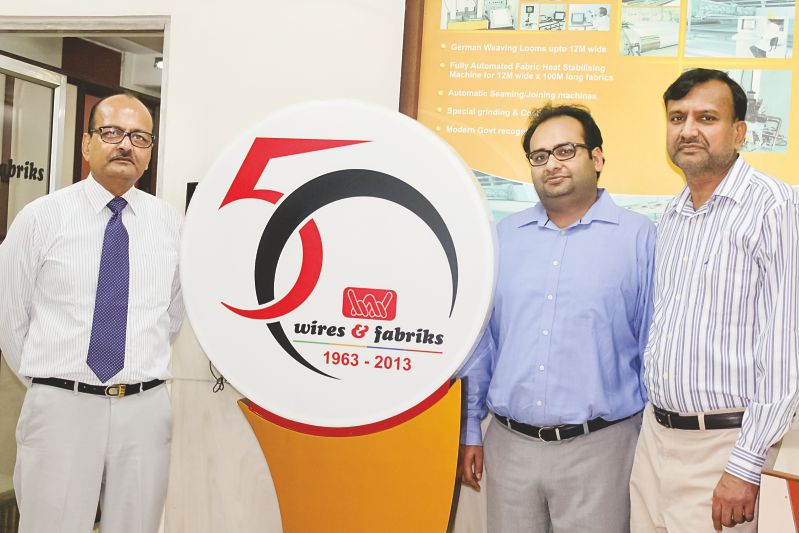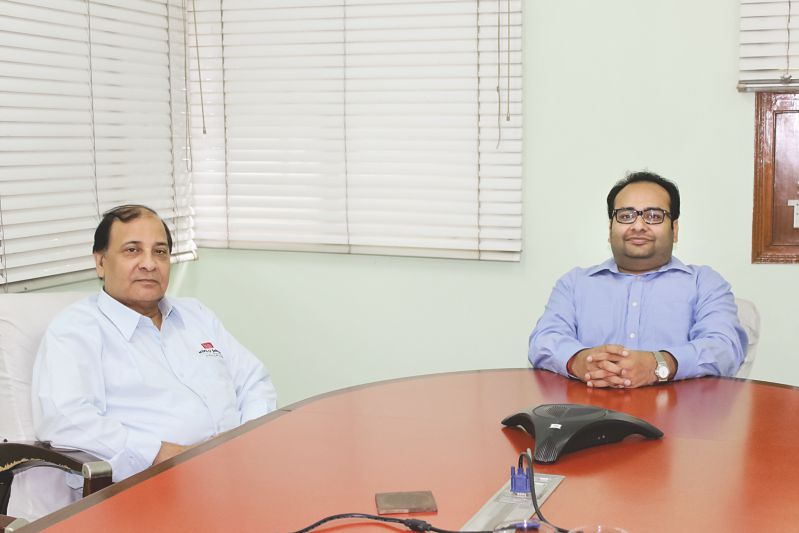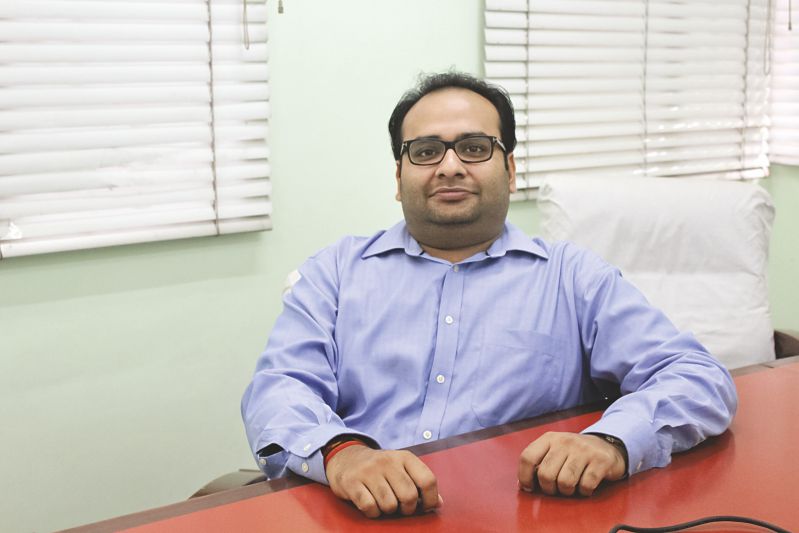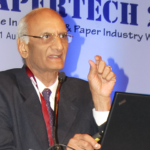Wires & Fabriks, an important manufacturers of specialty fabrics and performance chemicals for paper making and paper machine clothing, believes in churning out newer and different products to beat the competition. Tuning its product range with the help of global consultants of late has made its products globally competitive and a major exportable product to more than 25 countries.
Wires & Fabriks manufactures a full range of forming fabrics (for the wet-end), woven dryer screens, and spiral link dryer Screens (for the dryer section) for sophisticated and high speed paper machines. The company over time has become a leading exporter and over 30 percent of its production is sent to over 25 countries around the world. Besides, the company also manufactures woven fabrics for the pulp section (where pulp is made), paper machine clothing, technical textiles, paperboard and the effluent Treatment Plants (ETP) where effluents are treated and fiber is recovered).

Executive Director, Wires & Fabriks; M.K. Khaitan, Managing Director, Wires & Fabriks
Paper Mart recently interviewed Mr. Devesh Khaitan, Executive Director, the young spearhead of the company, and Mr. D.K. Raina, President (Marketing), Wires & Fabriks, who has about 40 years of paper industry experience behind him with BILT and Voith Paper Fabrics India Ltd. It was an insight into the company’s priority in domestic and export markets, its continuous product innovation, its leadership traits efforts to acquire global technological standards. Excerpts:
Paper Mart: Give us a brief detail of your product range. Is there any new development on the product, process, and market front? Are you planning any new expansion?
Devesh Khaitan: We are in such an industry where product, market and expansion go together. These are the three lifelines for any company to grow. We have been growing and introducing new products constantly. The current phase is quite exciting for us as we have developed 3-4 products and we are sure these products would do extremely well as these are crafted for booming packaging sector. Packaging is the new growth engine for the Indian paper industry. I won’t say writing and printing is not growing; it is growing of course but at slower pace in comparison to the packaging sector. Moreover, the Indian paper mills have yet to reach the desired levels with regard to technology and processes in packaging segment as compared to global counterparts. It is important for the Indian mills to see how to work upon the efficiency, technology, and economies of scale.
If I take the example of Wires & Fabriks products, there are still ample of mills using single layer products in our country as against mostly SSB fabrics in the western world. It is a real challenge to convert single layer to SSBs directly. Step by step, we are crossing the ladders. With these new products, we are growing in India as well as outside India even though finding new countries in exports is becoming a bit of a challenge.

Mr. Devesh Khaitan, Executive Director, Wires & Fabriks.
D.K. Raina: If the processes and markets change or develop we have to align ourselves with it at any cost, be it with investments, technology upgradation or whatever it takes. That I can say is in our company’s DNA since our inception 50 years back. That’s the reason why we are always aggressive in introducing new products, be it Single Layer Fabrics in the market where metal fabrics were being used or multilayer Fabrics in the domestic market to substitute imported fabrics, and again we were the first to introduce the new generation SSB range of Forming fabrics in India, branded by us as STL.
PM: Kindly share with us some new developments at Wires & Fabriks on expansions or some new product launches.
DK: We have recently concluded a considerable expansion, which was going on for the past three years. In the financial year 2016-17, we finished the expansion, which included the installation of a new loom. We also expanded in our seaming section by adding state-of-the-art seaming machines. The seaming process is now fully automatic, which earlier was semi-automatic. We have added two modern tables for heat stabilization of fabrics. I could proudly say that one of the heating tables is 60 percent engineered by us. Though we have outsourced the products, the table is made by our own engineering department. These are the broad and major expansions that we have done over the past 2-3 years.
DKR: Our SSB range of products, steered by STL, is our recent success story, which is still going on with its new variants and engineered designs. Due to our huge and continuous investments in technology, expansions and new processes in the last few years, we have been able to launch and successfully supply customized solutions with our STL fabrics to suit changing needs and wants of papermakers. We always keep a track of the developments and trends in Indian as well as overseas markets, and keeping in tune with the future projections for Indian paper industry, we have launched our new ULTRA series of SSB range of forming fabrics called ULTRAPACK and ULTRAEDGE. These fabrics are specifically designed for packaging grades keeping in mind the growth of this segment in India

PM: How does Wires and Fabriks gears up to a global platform?
DK: Customers today take quality and price for granted. Besides, we work constantly to score an edge over our competitors by hiring global level consultants, who help us to bridge the gap in technology if any. This way we enhance the quality of our products to required global standards. Furthermore, if I talk about the Indian paper industry, it is fast catching up with the west. Whatever the western world does, the paper industry in India adopts the same quickly.
DKR: As the cliché goes, world is becoming a smaller place. With easy access to information, data, and knowledge, paper industry all over the world has become aware of the latest trends, technologies, designs, etc., in our field. Since Exports is one of the mainstays of growth in our field, there is a constant pressure on us to be equal to other global players. Thus, to execute our growth strategy we have to update ourselves continuously in all the fields whether its machines, knowledge base, service, architecture, etc. We execute this through our investment programme and regular interacting with international experts in the field.
PM: With the technological advancements in the paper industry, how are your products matching the pace? What are some of the newer challenges you are facing in the paper industry?
DK: Our company believes in developing newer products all the time. We have at least 10-15 products in the pipeline, or I should say in the idea stage. Idea is the first step in product innovation and we take it seriously. We have a team who ideates on how to generate new products. The two products which I mentioned above remained in the development stage for the 6-10 months. At least 3-4 of these products should come out in the next 6 months. The reason why we develop these products is to stay ahead of the competition.
As I mentioned earlier, quality and price are given for the customers; if I make a particular quality, then I have to differentiate my product in some way. The differentiating factor for me is the product and its application knowledge. Besides, the expansions that we have done are really helping us in making the new developments.
Among many challenges we face, one is when we develop a product and it starts doing well in the market but often we have to phase out our own product and come up with a new product in spite of the product running good in the competition. The truth is that one has to kill one’s own product to stay ahead in the competition.
DKR: The changing face of the Indian Paper Industry is a big challenge for us to excel in our field. Today, with excellent technocrats running some of the latest and fast machines in India, we feel delighted to see the progress made in the country in terms of in-house expertise and their new approach towards manufacturing. As mentioned earlier, in addition to modernize our factory in Jaipur, we have also continuously strived to increase our knowledge base through overseas training of our people and having collaborations with other companies and global experts from leading paper producing countries. This has really helped us to see the new and modern Indian Paper Industry with a different view, not only in terms of product offerings or competitive prices, but also with respect to the latest servicing requirements.

PM: How many countries are you exporting to right now and which are the geographical regions you intend to touch?
DK: We are exporting to around 25 countries right now. Instead of just adding the number of countries, what has become more meaningful for us is the growth in existing as well as new customers in same country. In India we don’t ask how many mills you are supplying to; it is the number of customers you are going to deliver your product. In the same way, we want to work in exports and increase number of customers that we are dealing with.
Obviously, we have a huge growth plan to double our export base in the next 2-3 years. There are many countries in our mind. At the present time, we are in a challenging phase because we are tapping the large customer base through which we can face competition from the European countries. It’s a shift that we are planning to do in the new countries like Africa, Eastern Europe, and Southeast Asia. As we are already big in Southeast Asia, we have lot of expectations from that area.
DKR: Instead of just growing in terms of number of countries, we strategise to grow in the number of customers that we can cater to in each of our target countries. All our plans and actions are designed to further deep dive into countries where we already have a foot hold. This increase in market share will come from our designs under development phase, new launches of ULTRA series of SSB forming fabrics along with new variants of our existing range of STL.
PM: Tell us about your products which have huge domestic and international demand.
DK: When we say products, there are two products; one is forming fabric and the other one is dry screen. In dry screen we have developed (UNOTIER), which is a new generation of screens and have a lot of advantages. This is one product that is growing fast in India. This replaces the normal woven screens. It has certain advantages. In India, the two most important products in Forming Fabrics that are still being used is single layer, which lot of kraft mills and small mills use. SSB is a growing product, which will rule in the future in small and medium packaging grades also.
DKR: In domestic market, in addition to fulfilling the existing demand of machine clothing, we also feel responsible to offer new and latest designs to some of the Indian mills who for various reasons still continue to use existing or old designs. Our Technical Services team which consists of experienced paper technologists constantly interacts with them and helps them to try out new products like UNOTIER dryer screens or STL or ULTRA series Forming Fabrics. So, in our own small way we also contribute to improve and upgrade the mills in addition to just fulfilling their demand for existing products. Close partnership with Indian Paper mills is the prerequisite for achieving this task and in this regards we always get full cooperation from them which obviously arises from their confidence in our team, knowledge base, products and services.
PM: Tell us about your Indian market. How many companies are you catering to right now? What according to you are the current trends with respect to your product going on in the Indian market?
DK: We are catering to about 500 mills right now. We cater to newsprint, writing-printing, kraft, and specialty papers. We cover almost all the areas. The customer is taking quality and price for granted. Whenever you talk or sit on a negotiation table with a customer, these two things are considered by default. You don’t have to repeatedly tell them that my quality is better than others. Now, what is happening is they are becoming more demanding; demanding in the sense of repeatability. They want the same thing again and again as the Indian customers have realized that the downtime costs money. This consciousness has come inside most of the paper mills. That is why repeatability has become a very critical thing.
The mills are even demanding from us to solve their customer problems. We don’t visit their customers, but we do have an interaction with them. We ought to give paper mills a holistic solution to their problems. This is how it works. It is getting trickier for us because till now we had approximately 15-20 percent of customer bracket, who were behaving and demanding like this. Now that number is increasing. May be 2-3 years down the line it will become 40-50 percent.
A lot of medium or small scale mills have now started to look into automation. Five years ago, automation was for US or Europe. Automation is good for the industry. It does not mean that you are cutting down the labor force. It just means that you are bringing in more efficiency in the product.
DKR: Today, the customers demand solutions rather than just the product or price or service. We are aware that this requirement is going to become more stringent in future and only those companies shall be able to grow who have the capability to invest in constant upgradation of their knowledge base. Thus, as DK said, we have to look at the business in a very holistic way. We are able to execute this due to benefits arrived by learning from our international consultants and the synergy we acquire due to our other divisions and associate companies in the field of engineering accessories like showering systems, filters, doctoring equipments, performance chemicals etc.
PM: There are other notable names in the market catering to the needs of paper machine clothing. How do you respond to the competition from their products in the market? Tell us something about your marketing strategy that puts USPs of your product to the fore.
DK: One way to be ahead of the competitor is by doing something new. Our one of the USPs is product; second one is hiring good consultants or being in touch with good people from the western world to bridge the gap. This way I can bridge the gap with my competitors by staying a scale up. We see we are replacing our western competitors in certain machines. Although, we still have a long way to go but we are moving in that direction. The only way we have been able to do is service and product. We have matched the imported products, and in some cases we have gone beyond.
DKR: Our competition in the market is made up of leading and big international western names on one extreme and low priced inconsistent quality products from Far East countries on the other extreme. Often high-tech offerings from world leaders prove over kill for many mills .Moreover, the service levels of a domestic supplier available a phone call away can in no way be matched by a vendor situated thousands of miles away. Ours is a consumable high-tech product critical to papermaking and quick or timely servicing ability does score a high point In terms of a supplier evaluation. Cheap products on the other hand ultimately prove very expensive. This is because our products being customer-specific, need constant optimization which is possible only with frequent and on demand visits and interaction with the mills. So in terms of handling competition we are rightly placed in India. If the USP of other suppliers could be either high research budgets at one end and low priced products on the other hand, our USP is “design development and application” to suit local conditions as against pure and basic research or playing on price.
PM: Paper machines are operating at much faster speeds, with a furnish mix that often contains more short fibers and a higher level of fillers, and other such developments. In terms of technology and product development, how are you responding to these new demands?
DK: We have a full-fledged design team. As I said, the first thing the design team does is the idea. They keep on visiting the mills to see the issues and generate ideas. They interact with the mills and take note of the raw materials they are using. Our product is the one on which the raw material lands first. Therefore, we need to closely interact with the raw material. We get a lot of feedback from the mills and the countries we export to. We also get new samples of our competitors from the western countries. Taking all these things into consideration, we start our development process. We have to cater to our Indian environment as well. Then development of our product starts. Taking these things together, our design team first comes with a concept. After these concepts, they then go into how we can design this. Our technology has the expansion and modernization, which has helped us brining in the new product.
DKR: As already mentioned, we are very strong in developing latest designs of fabrics to suit local mills. We have a vast database compiled for the last 50 years. We have a team of paper technologists who visit mills very frequently and thus are highly aware of the trends or local issues of fiber quality, machine runnability, energy conservation, water management, etc. This coupled with our huge experience in dealing with mills for almost half a century now enables us to handle and advise the mills accordingly for optimizing their operations.
PM: What are your views in general on the Indian pulp and paper industry, where it’s heading and main demand drivers in years to come?
DK: It is one of the most sustainable industries globally. The paper industry is a sustainable industry because anything apart from paper cannot dissolve within two days. If you leave paper on ground, it will get dissolved as quickly as possible. Other products take much more time as compared to paper. This gives an assurance that paper is at least eco-friendly. The world is moving towards eco friendly products.
DKR: I agree with DK and would like to add that as an industry, all the captains and leaders have to get together and organize themselves to convey the point of sustainability to the industry at large, and specifically to the environmentalists. The story of papermaking process from forestry to paper degradation is absolutely sustainable. I feel that all the growth drivers are in place whether its high efforts on high literacy levels, urbanization growth, increasing industrialization, favorable demographics, etc. Of course, the product mixes might change as compared to existing one with more emphasis on packaging grades and tissues
PM: Anything you would like to add for the paper industry because as a team you bring both the factors in your company – the youthful energy as well as a rich experience?
DK: I am too young to say anything on paper industry but still I would like to say that the trend in paper industry of having the same mindset should get changed. If I buy something, it does not mean that it is good for anyone else. We have to evolve our destiny with technology. We cannot depend on others.
DKR: The growth story for the paper industry in India is there for sure and will definitely reveal itself if we all handle the growth drivers with professional excellence. I am confident that this optimism will not just remain on paper, pun intended.



